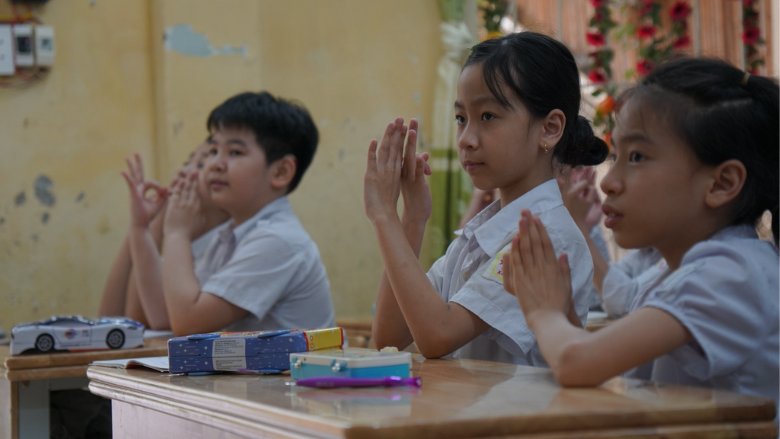Lo Mu Du Ly-Et was born in 2010 to deaf parents belonging to the Cil (K’ho) ethnic group in the central highland province of Lam Dong in Vietnam. Ly-Et’s parents’ deafness was considered a burden to their families, but they overcame that stigma, raised a family together, and wanted their child to have opportunities that had been unavailable to them.
“Ly-Et came to us without any language skills, not in writing, reading or sign,” said Nguyen Thi Ngoc Minh. “We were lucky to be able to access a good set of sign language materials suitable for primary school students so that she and her friends could learn quickly.”
The sign language that enabled Ly-Et to thrive was an outcome of the just-concluded Quality Improvement of Primary Education for Deaf Children Project (QIPEDC), administered by the World Bank with funding from the Global Partnership for Results-Based Approaches. This project has enriched the lives of Ly-Et and almost 2,000 other deaf children from 20 provinces across the country, well more than the 1,200 originally envisioned. In addition to a set of 4,000 gestures for communication among deaf children and the deaf community, the project also developed a series of 150 video lessons to cover math and other subjects for students in grades one through five.
Though sign language is not new to the Vietnamese deaf community, it has not been introduced widely as an official language for teaching and learning for children. Since the World Bank-managed Intergenerational Deaf Education Project (IDEO) introduced a set of 2,000 gestures in 2015, however, sign language has gradually become part of preschool and kindergarten curricula. Even so, most of Vietnam’s estimated 116,000 deaf children rely solely on methods such as reading lips or wearing hearing aids to communicate.
A lesson using QIPEDC provided materials in Xa Dan school for deaf children in Ha Noi capital city.
When QIPEDC wound down in September 2022, Vietnam’s Ministry of Education and Training agreed to authorize the use of such materials nationwide to ensure these valuable training and learning resources would continue to benefit teachers and students beyond the life of the project.
“Thanks to the project, deaf students are better connected and communicate with one another much more,” said Nguyen Hoang Lam, one of the project’s deaf coordinators.
Students’ ability to communicate through sign language also opens the door for learning opportunities, and teachers are provided with additional resources for better teaching and communicating with deaf students.
Nguyen Kim Ngan, a deaf student in Hanoi’s Xa Dan primary school is one student for whom expanded interactions through signing have been life-changing.
“I love social science and natural science subjects at school,” she said. “I love to come to school to play with my friends, too.”
The project piloted an approach to integrate deaf children into the mainstream and special education through the engagement of parents, caregivers, teachers, and deaf mentors, as well as the community at large. Almost 400 deaf adults like Lam received training on the new signs to enable them to provide sign language education for deaf children.
Tran Duc Loi, Deputy Director of Lam Dong Province Department of Education and Training said a particular value of the project was that it connected deaf children, deaf adults, parents, and teachers and created a support community for deaf children.
“Now, they have the confidence to communicate with others,” Loi said.
The mother of a deaf child, Le Thi Huyen, had the same epiphany. After working as a facilitator and sign language interpreter for the family support team in the IDEO project, she pursued a bachelor’s degree in special education to become a deaf teacher. She is one of the almost 1,800 parents that have received training under the QIPEDC project, despite the difficulties posed by the COVID-19 pandemic.
In that respect, she was similar to Nguyen Thi Ngoc Anh, one of the 429 teachers who received training under the project, and who believed that deaf children could learn similarly to their hearing peers if they were taught sign language as early as possible. As the positive impact of the training courses became apparent, many project provinces have shared training materials with other schools outside the scope of the project to meet the needs of the teachers in specialized and inclusive schools.

A lesson using QIPEDC provided materials in Thuan An school for disabled children, southern Binh Duong province.
With this additional training and the dissemination of training materials, the test scores of deaf students in the schools supported by the project improved significantly, achieving a 97 percent examination pass rate, well above expectations.
With better learning results, Tong Thi Nga, the mother of a deaf child who has successfully passed the primary education level and now progressed to 6th grade, has an expanded view of her son’s future. Perhaps he may someday qualify for a scholarship for continued studies, maybe even abroad, she said.
“I hope that he can achieve his dream,” Nga said.
The project’s delivery of both educational and humanitarian benefits means the approach is worth expanding to reach older students, said Nguyen Thi Minh, Vice Minister of the Ministry of Education and Training.
“Implementation has been difficult, but the results are rewarding,” she said. “The 4,000 new signs are a good start, and we will need to work together on the next phases to help with other education levels.”

Teacher and students in Ba Ria school for deaf students during a lesson on the Vietnamese language with video material supported by QIPEDC.


